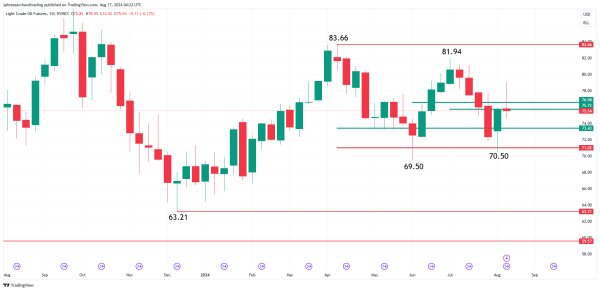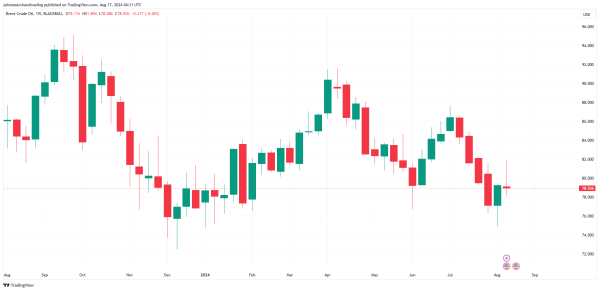Oil News: Will China’s Economic Struggles Push Crude Oil Prices Lower Next Week?
Oil Prices Falter as China Slowdown and Geopolitical Risks Clash
Crude oil markets faced significant volatility last week, as conflicting economic signals and geopolitical tensions pulled prices in opposite directions. Brent crude closed the week below the critical $80 per barrel mark, pressured by concerns over China’s economic slowdown despite earlier fears of supply disruptions from the Middle East. Traders navigated a market caught between bearish demand realities and potential geopolitical triggers.
Last week, Light Crude Oil Futures settled at $75.54, down $0.13 or -0.17%.

China’s Economic Slowdown Pressured Oil Prices
China’s economic difficulties weighed heavily on global oil markets throughout the week. New data highlighted major weaknesses, with new home prices plummeting at their fastest rate in nine years, industrial output slowing, and unemployment rising. These developments led Chinese refineries to sharply reduce crude processing rates, reflecting weak fuel demand and deepening concerns about global oil consumption.
In response, OPEC and the International Energy Agency (IEA) adjusted their demand forecasts downward. OPEC reduced its global oil demand growth projection for 2024 from 2.25 million barrels per day (bpd) to 2.11 million bpd, citing weaker-than-expected Chinese consumption. Similarly, the IEA lowered its 2025 demand growth forecast, citing the diminishing impact of China’s post-COVID recovery.
Geopolitical Tensions Provided Temporary Support
Despite the bearish demand outlook, geopolitical tensions in the Middle East provided intermittent support to prices. The ongoing conflict between Israel and Hamas, alongside threats of retaliation from Iran, kept supply disruption fears alive early in the week. The U.S. responded by increasing its military presence in the region, which initially sustained bullish sentiment in the oil market.
However, the risk premium associated with these geopolitical tensions diminished as the week progressed, with Iran refraining from immediate retaliatory actions. This allowed market focus to shift back to the more pressing concern of weak global demand, particularly from China.

U.S. Economic Data Offered Mixed Signals
In the United States, economic indicators offered some support for oil prices, but the impact was limited. Speculation of an interest rate cut by the Federal Reserve, fueled by lower-than-expected inflation data, suggested potential future support for oil demand in the world’s largest economy. However, U.S. crude inventories reported by the Energy Information Administration (EIA) showed an unexpected build, indicating that domestic demand may not be as robust as anticipated, which added to the market’s bearish tone.
Market Forecast: Bearish Outlook on Global Demand Concerns
Looking ahead, the outlook for oil prices remains bearish as global demand concerns, particularly from China, continue to dominate market sentiment. While geopolitical risks in the Middle East remain a potential wild card, the absence of immediate supply disruptions and ongoing weak demand signals suggest that crude oil prices may struggle to gain upward momentum. Brent crude is expected to remain under pressure, potentially testing lower support levels if demand concerns persist. Traders should stay vigilant for any developments in China’s economic policy or unexpected geopolitical escalations that could alter this bearish forecast.